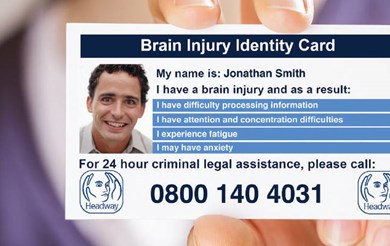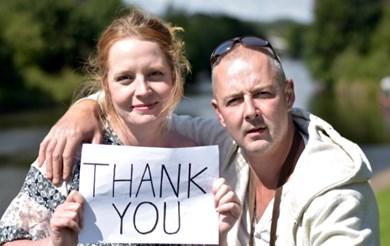At the hospital after brain injury
This page explains:
- Tips for coping at the hospital stage
- The neurosurgical unit
- Neurosurgery
- General hospital ward
- I’m calling about Chris: Connect, share and update those who care
Tips for coping at the hospital stage
- Refer to the Headway booklet Hospital treatment and early recovery after brain injury for general information about what might happen while the person with the brain injury is in hospital. Encourage other family members or friends to read this booklet if they need information or guidance as well. You can download the booklet from the related resources section below, or from our information library.
- Don’t be afraid to ask close friends and other family members for help with practical jobs such as shopping, childcare or researching where you can all get support from, such as through the hospital or from Headway.
- When visiting the person with the brain injury, try not to overwhelm them with too much information or engage them in lengthy discussions, as they may struggle with fatigue or processing information.
- The nurse-led Headway helpline and Headway’s network of groups and branches are also available to answer questions, give information about brain injury and offer emotional support to you or other family members.
- If you are unable to visit the person with the brain injury in hospital, write down any questions that come to you through the day and suggest that someone else visiting asks the hospital team questions on your behalf.
- Ask to be involved in meetings about the person with the brain injury’s care so that you are kept up-to-date about their treatment and the next stages. If you are struggling with finding out about meetings, contact the hospital’s Patient Advice Liaison Service, details of which will be available at the hospital’s main reception.
- Ask nursing staff whether you can assist with caring for the person with the brain injury. This can help you to feel close to them.
The emergency department
After the accident, the person with a brain injury should be taken to the nearest emergency department, where a doctor will carry out an initial assessment. After a serious accident it is possible that the person with brain injury may also have other injuries that need more urgent attention.
Doctors will make an assessment and prioritise the treatment required based on the most urgent clinical need. The medical team will check breathing and any blood loss,replacing any blood that has been lost with a transfusion. If the person is unconscious they will be unable to keep their throat clear and a tube will be put through their nose or mouth into the windpipe to help with breathing. This is called an endotracheal tube and is connected to a ventilator, which takes over the person’s breathing mechanically. This ensures that the brain is kept well supplied with oxygen.
Medical staff may arrange various X-rays and will also check for further complications, such as blood clots or bleeding in the brain. To do this they will need to carry out a CT or MRI scan of the head.
The neurosurgical unit
After the initial assessment, the doctors may decide to send the patient to a neurosurgical unit. This will help to obtain a much clearer picture of the brain injury, its potential effects and what treatment is needed. Neurosurgical centres are frequently based in major cities and so the person with a brain injury may need to be transported a long distance by ambulance or helicopter.
On arrival, the neurosurgeon will usually review the scans done at the local hospital or arrange for a brain scan if this was not done. This will help them to assess the extent of damage to the brain and decide whether an operation is necessary.
Neurosurgery
If there is a blood clot large enough to damage the brain, or if there is pooling of blood or cerebral oedema, an operation will be needed. During surgery, a flap of bone is cut out of the skull over the site of the clot (a ‘craniotomy flap’). Once the clot has been removed and damaged blood vessels repaired, the bone will then be replaced. In certain circumstances the bone may be left out and not replaced until later on in the recovery process. This decision will be made by the neurosurgeon during surgery.
The skull heals rapidly and normally leaves no area of weakness. Many people are particularly worried about the effects of an operation on the head, but in fact, the surgery itself is usually straightforward and without much risk. The most important factor is the injury that made the operation necessary in the first place.
An operation will also be needed if there is a wound that goes through the skull into the brain. Wounds of this sort may look frightening, but with proper treatment the external injury can often heal well. As with any traumatic brain injury there could be a future tendency to epileptic seizures, known as post-traumatic epilepsy, following this type of injury. The patient may be prescribed specific medication to reduce the risk of this occurring.
A neurosurgical operation is a delicate and lengthy procedure and can take a very long time. After the operation the person with a brain injury may take a long while to recover consciousness. This can be as a result of the anaesthetic, but is more often the result of the brain injury itself. The overall rate of recovery will depend on the severity of the brain injury, rather than on whether or not an operation has been performed.
Intensive care unit
After any neurosurgery has been carried out the patient may be taken to an intensive care unit (ICU) or neurological high dependency unit (HDU). Here they will be looked after 24 hours a day by highly trained staff, using specialised equipment to assess and treat them.
Just as in the early stages, staff will be checking the person’s heart rate and blood pressure, testing brain function and controlling intake of fluids and food. Drugs may be used to keep your relative sedated at this time. The main priority is to reduce the risk of further damage while any bruising settles down and to prevent any further swelling of the brain.
The intracranial pressure may be carefully monitored using a special tube inserted into the head, usually called an intracranial pressure (ICP) monitor. This will not do any damage and will only leave a tiny scar under the hair. It will enable the doctors to know whether drugs are needed to relieve swelling and increased pressure.
In the early stages a drip (or IV, for intravenous infusion) may be used to supply the person with essential nutrients. Once the person is past the emergency stage, but is still unconscious or unable to swallow, food may then be fed to them using either a nasogastric tube (which is placed through the nose and into the stomach) or a percutaneous endoscopic gastrostomy tube (more commonly called a ‘PEG tube’).
This can be a confusing time for families, as the person with a brain injury may be taken off for a series of tests, assessments or even operations. Be sure to ask the medical staff if you are unsure what is happening.
If you feel that your questions have not been fully answered, you can make an appointment to see the consultant in charge of your relative’s care. This will give you more time to discuss any concerns. Before the appointment write down any questions as you think of them, so that you don’t forget to mention them to the consultant.
General hospital ward
Once they are out of the emergency stage, there is less need for intensive nursing and your relative may be moved onto a general hospital ward.
He or she may still be highly dependent on nursing care. They may not be able to swallow properly yet and may still require the nasogastric tube that was used for feeding while in intensive care. Your relative may not have recovered enough strength to hold their head up, or to sit up on their own and may not be able to communicate properly yet. However, they will know, even if in a rather confused way, that their family and friends are with them and this will be a comfort and a great source of strength to them.
You may feel at this stage that you want to do more for your relative and you can discuss this with the nurse in charge. You may be shown how to take over simple nursing tasks or rehabilitation exercises, although it is important that this is done under the supervision of the hospital staff, since if things are done wrongly they can cause further complications.
I’m calling about Chris
I’m calling about Chris is a new website from Headway that aims to help next-of-kin keep people up-to-date with their loved one’s progress while reducing the pressure of updating them individually.
Similar to Facebook, it offers a news feed and space to post photos, while visitors can reply to posts and offer support. There is also a wealth of information for next-of-kin, extended family and friends to help find out more about brain injury, treatments, rehab and the best ways to offer support.
If they haven’t already set up a page, let the next-of-kin know about this website by sharing it with them.
Early rehabilitation after brain injury
Find out about the early rehabilitation that can be expected after brain injury, including physical abilities, memory, concentration and fatigue.
Find out moreDischarge from hospital after brain injury
Find out about the process of discharge after brain injury, and the steps you can take to ensure you get the right support in the future.
Find out moreHeadway Emergency Fund
The Emergency Fund provides one-off small grants to help adult brain injury survivors and their families cope with the practical implications of brain injury.
Find out moreSupporting children: visiting a parent in hospital
Find out moreThe information in this section is adapted from the Headway booklet Hospital treatment and early recovery after brain injury by Dr Chris Maimaris and Esme Worthington.












